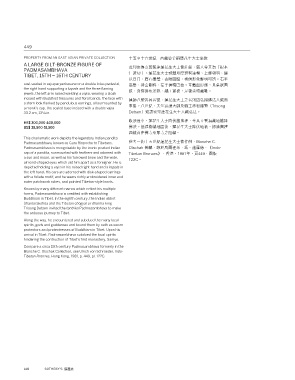Page 142 - Sotheby's Chinese Ceramics Nov 30 2017 Hong Kong
P. 142
449
PROPERTY FROM AN EAST ASIAN PRIVATE COLLECTION 十五至十六世紀 西藏鎏金銅蓮花生大士坐像
A LARGE GILT-BRONZE FIGURE OF 此印度傳奇班智達蓮花生大士像莊嚴,藏人尊其為「根本
PADMASAMBHAVA
TIBET, 15TH – 16TH CENTURY 仁波切」。蓮花生大士頭戴印度班智達帽,上飾翎羽,綴
以日月,眉心攢蹙,杏眼圓瞪,番僧形象鮮明可辨。右手
cast seated in vajraparyankasana on a double lotus pedestal, 高舉,持金剛杵,左手握嘎巴拉。耳戴盤形飾,見葉狀圖
the right hand supporting a kapala and the three flaming 紋,身穿拼布法袍,繡工繁複,足著尖頭藏靴。
jewels, the left arm raised wielding a vajra, wearing a cloak
incised with Buddhist treasures and floral bands, the face with
蓮師八變各具名號,蓮花生大士之名則因弘揚佛法入藏而
a stern look flanked by pendulous earrings, all surmounted by
享譽。八世紀,天竺寂護大師及藏王赤松德贊(Trisong
a monk’s cap, the sealed base incised with a double vajra
33.2 cm, 13⅛ in. Detsen)迎請密宗蓮花生大士入藏弘法。
跋涉途中,蓮花生大士降伏諸鬼神,令其立誓為藏地護持
HK$ 300,000-400,000
US$ 38,500-51,500 佛法。抵達衛藏地區後,蓮花生大士降伏地祇,掃清興建
西藏首座佛寺桑耶寺之阻礙。
This charismatic work depicts the legendary Indian pandita
Padmasambhava, known as Guru Rinpoche to Tibetans. 參考一約十五世紀蓮花生大士像作例,Blanche C.
Padmasambhava is recognisable by the iconic peaked Indian Olschak 舊藏,錄於烏爾裡希.馮.施羅德,《Indo-
cap of a pandita, surmounted with feathers and adorned with Tibetan Bronzes》,香港,1981年,頁449,圖版
a sun and moon, as well as his furrowed brow and the wide, 122C。
almond-shaped eyes which set him apart as a foreigner. He is
depicted holding a vajra in his raised right hand and a kapala in
the left hand. His ears are adorned with disk-shaped earrings
with a foliate motif, and he wears richly embroidered inner and
outer patchwork robes, and pointed Tibetan-style boots.
Known by many different names which reflect his multiple
forms, Padmasambhava is credited with establishing
Buddhism in Tibet. In the eighth century, the Indian abbot
Shantarakshita and the Tibetan chögyal or dharma king
Trisong Detsen invited the tantrika Padmasambhava to make
the arduous journey to Tibet.
Along the way, he encountered and subdued the many local
spirits, gods and goddesses and bound them by oath as sworn
protectors and protectresses of Buddhism in Tibet. Upon his
arrival in Tibet, Padmasambhava subdued the local spirits
hindering the contruction of Tibet’s first monastery, Samye.
Compare a circa 15th century Padmasambhava formerly in the
Blanche C. Olschak Collection, see Ulrich von Schroeder, Indo-
Tibetan Bronzes, Hong Kong, 1981, p. 449, pl. 122C.
140 SOTHEBY’S 蘇富比

